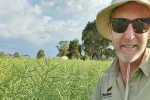Expanded market options for better sorghum
GRDC has invested in two projects designed to improve the value proposition of sorghum crops.
Photo: GRDC
Expanded market options for better sorghum
GRDC has invested in two projects designed to improve the value proposition of sorghum crops.
Photo: GRDC
The challenge
Grain sorghum is an important summer crop, especially in Queensland, given its high-water use efficiency and heat tolerance. Almost all Australian sorghum grain, however, is used domestically for animal feed (beef, dairy, pigs, poultry) or exported, particularly to China.
Despite its end-use as a feed grain, sorghum is perceived to have poorer grain quality traits when compared to other feed grains. This includes a reputation for having low protein content (although it is higher than corn), poor digestibility and often small or variable grain size.
These traits create a ceiling on market prices and on expanding sorghum use into higher-value human food and beverage products.
Given the benefits to Australian cropping system of sorghum’s resilience to hot and dry environments, the question was raised as to whether sorghum’s market value could be enhanced on the back of improved grain quality.
The response
From 2016 to 2022, GRDC invested in two projects designed to improve the value proposition of sorghum crops. The aim of these projects was to:
- Increase the quality and grain size of sorghum with gene editing techniques and test new sorghum lines in field conditions (in research led by University of Queensland) and poultry feeding trials (led by University of Sydney).
- Support the expansion of Australian sorghum industry into high value food and beverage markets, by improving market intelligence of the Chinese baijiu market and by testing how Australian sorghum varieties perform in optimised Baijiu fermentation trials (research led by Charles Sturt University), and by investigating the food processing properties of Australian sorghum varieties (led by University of Sydney).
These investments succeeded in creating new sorghum varieties with higher protein, higher digestibility and larger grain size. The larger grain size was achieved without a reduction in grain number or in protein levels.
Australian sorghums were also found to have suitable physio-chemical properties for new food products and Baijiu production. This breakthrough created potential to expand supply of Australian sorghums into the China Baijiu market.
The impact
An economic analysis on these investments was performed at the Centre for Agricultural Economics and Development at the University of Western Australia by Dr Marit Kragt and Dr Fiona Dempster.
Both projects were found to have contributed to important knowledge development, in sorghum breeding (UOQ1806-004RTX) and in the use of sorghum as an ingredient for foods and drinks (UCS1607-003RTX).
Overall, the analysis found that the potential benefits to growers generated by the projects are likely to outweigh the direct investment costs, provided that adoption occurs.
The estimated worth of total discounted benefits was $58.3 million for an investment of $22.8 million. This amounts to a Benefit-Cost Ratio (BCR) of 2.56, which gives an internal rate of return (IRR) of 10 per cent and a Modified Internal Rate of Return (MIRR) of seven per cent.
Opportunities also exist for additional benefits given ongoing development work to create elite commercial sorghum hybrids through commercial seed companies who have expressed interest in the new sorghum germplasm.
More information: Delivering impact case studies.

























































